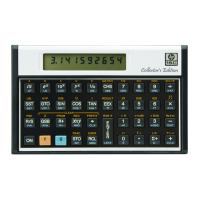Section 12: Calculating with Matrices 167
8. Press * to calculate YX
P
= (YX)
P
. The values of these matrix
elements are placed in the result matrix, and the descriptor of the
result matrix is placed in the X-register.
9. If you want the product in the form (YX)
C
, press | c.
Note that you don’t transform X
P
into X.
You can derive the complex elements of the matrix product YX by
recalling the elements of (XY)
P
or (YX)
C
and combining them according to
the conventions described earlier.
Example: Calculate the product ZZ
−1
, where Z is the complex matrix given
in the preceding example.
Since elements representing both matrices are already stored (Z in A and
(Z
−1
)
P
in B), skip steps 1, 3, 4, and 6.
Keystrokes Display
l > A
A 4 4
Displays descriptor of
matrix A.
l > B
b 4 2
Displays descriptor of
matrix B.
´ < C
b 4 2
Designates C as result matrix.
*
C 4 2
Calculates Z(Z
−1
)
P
= (ZZ
−1
)
P
.
´ U
C 4 2
Activates User mode.
l C
C 1,1
Matrix C, row 1, column 1.
(Displayed momentarily while
last key held down.)
1.0000
Value of c
11
.
l C
-2.8500 -10
Value of c
12
.
l C
-4.0000 -11
Value of c
21
.
l C
1.0000
Value of c
22
.
l C
1.0000 -11
Value of c
31
.
l C
3.8000 -10
Value of c
32
.
l C
1.0000 -11
Value of c
41
.
l C
-1.0500 -10
Value of c
42
.
´
U
-1.0500 -10
Deactivates User mode.

